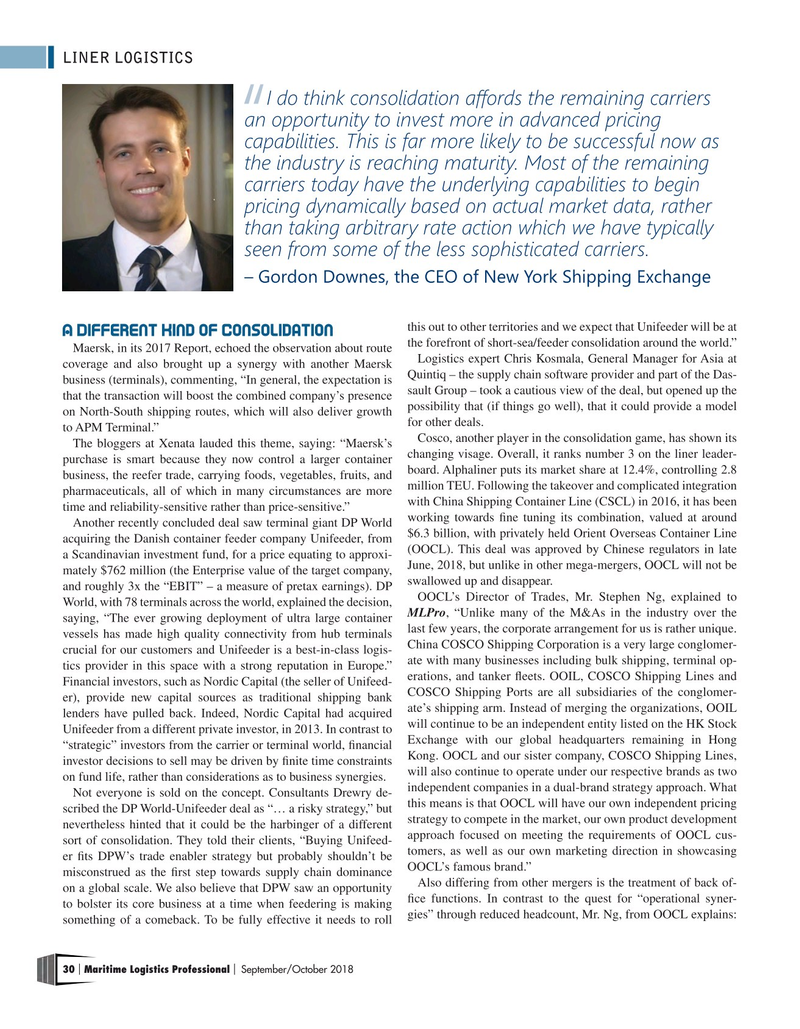
Page 30: of Maritime Logistics Professional Magazine (Sep/Oct 2018)
Liner Shipping & Logistics
Read this page in Pdf, Flash or Html5 edition of Sep/Oct 2018 Maritime Logistics Professional Magazine
LINER LOGISTICS
I do think consolidation afords the remaining carriers an opportunity to invest more in advanced pricing capabilities. This is far more likely to be successful now as the industry is reaching maturity. Most of the remaining carriers today have the underlying capabilities to begin pricing dynamically based on actual market data, rather than taking arbitrary rate action which we have typically seen from some of the less sophisticated carriers.
– Gordon Downes, the CEO of New York Shipping Exchange this out to other territories and we expect that Unifeeder will be at
A Different Kind of Consolidation the forefront of short-sea/feeder consolidation around the world.”
Maersk, in its 2017 Report, echoed the observation about route
Logistics expert Chris Kosmala, General Manager for Asia at coverage and also brought up a synergy with another Maersk
Quintiq – the supply chain software provider and part of the Das- business (terminals), commenting, “In general, the expectation is sault Group – took a cautious view of the deal, but opened up the that the transaction will boost the combined company’s presence on North-South shipping routes, which will also deliver growth possibility that (if things go well), that it could provide a model for other deals. to APM Terminal.”
Cosco, another player in the consolidation game, has shown its
The bloggers at Xenata lauded this theme, saying: “Maersk’s purchase is smart because they now control a larger container changing visage. Overall, it ranks number 3 on the liner leader- business, the reefer trade, carrying foods, vegetables, fruits, and board. Alphaliner puts its market share at 12.4%, controlling 2.8 pharmaceuticals, all of which in many circumstances are more million TEU. Following the takeover and complicated integration with China Shipping Container Line (CSCL) in 2016, it has been time and reliability-sensitive rather than price-sensitive.” working towards fne tuning its combination, valued at around
Another recently concluded deal saw terminal giant DP World acquiring the Danish container feeder company Unifeeder, from $6.3 billion, with privately held Orient Overseas Container Line (OOCL). This deal was approved by Chinese regulators in late a Scandinavian investment fund, for a price equating to approxi-
June, 2018, but unlike in other mega-mergers, OOCL will not be mately $762 million (the Enterprise value of the target company, and roughly 3x the “EBIT” – a measure of pretax earnings). DP swallowed up and disappear.
OOCL’s Director of Trades, Mr. Stephen Ng, explained to
World, with 78 terminals across the world, explained the decision, saying, “The ever growing deployment of ultra large container MLPro, “Unlike many of the M&As in the industry over the vessels has made high quality connectivity from hub terminals last few years, the corporate arrangement for us is rather unique.
China COSCO Shipping Corporation is a very large conglomer- crucial for our customers and Unifeeder is a best-in-class logis- tics provider in this space with a strong reputation in Europe.” ate with many businesses including bulk shipping, terminal op- erations, and tanker feets. OOIL, COSCO Shipping Lines and
Financial investors, such as Nordic Capital (the seller of Unifeed- er), provide new capital sources as traditional shipping bank COSCO Shipping Ports are all subsidiaries of the conglomer- lenders have pulled back. Indeed, Nordic Capital had acquired ate’s shipping arm. Instead of merging the organizations, OOIL will continue to be an independent entity listed on the HK Stock
Unifeeder from a different private investor, in 2013. In contrast to
Exchange with our global headquarters remaining in Hong “strategic” investors from the carrier or terminal world, fnancial
Kong. OOCL and our sister company, COSCO Shipping Lines, investor decisions to sell may be driven by fnite time constraints will also continue to operate under our respective brands as two on fund life, rather than considerations as to business synergies. independent companies in a dual-brand strategy approach. What
Not everyone is sold on the concept. Consultants Drewry de- this means is that OOCL will have our own independent pricing scribed the DP World-Unifeeder deal as “… a risky strategy,” but nevertheless hinted that it could be the harbinger of a different strategy to compete in the market, our own product development approach focused on meeting the requirements of OOCL cus- sort of consolidation. They told their clients, “Buying Unifeed- er fts DPW’s trade enabler strategy but probably shouldn’t be tomers, as well as our own marketing direction in showcasing misconstrued as the frst step towards supply chain dominance OOCL’s famous brand.”
Also differing from other mergers is the treatment of back of- on a global scale. We also believe that DPW saw an opportunity to bolster its core business at a time when feedering is making fce functions. In contrast to the quest for “operational syner- something of a comeback. To be fully effective it needs to roll gies” through reduced headcount, Mr. Ng, from OOCL explains: 30 Maritime Logistics Professional September/October 2018 | |

 29
29

 31
31
